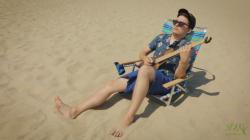John Petrucci (AKA The Master of Shred, AKA The Father of Notes, AKA Beard Wizard Supremo) is known for his ability to wail away on some of the toughest electric guitar passages out there. With his legendary work in Dream Theater, Petrucci has become a household name in the guitar world. But what about his acoustic guitar playing?
Petrucci recently sat down with The Captain from Andertons Music Co. to talk about all things guitar. The interview eventually lands on the topic of live acoustic guitar performances, which if you’re like me, you probably thought “Huh, John Petrucci plays acoustic guitar?”. Well he sure does, and he goes in-depth into how the magic happens live!
In one section of the interview, Petrucci dives a little more into some of the details of his live acoustic setup:
“One of the great things about [my signature] guitars – it has the piezo system in it. So you could either have the complete acoustic sound, you could have magnetic, or you can have both. It’s something I use a lot. What I’ll do in the studio, I would layer clean guitars. So left-right, maybe two of those, and then I’ll layer the same thing on an acoustic, and we blend it all together. Probably a really good version of that would be ‘Pull Me Under’ when you hear the opening of that track. That’s six different guitars playing together. And that’s how you have the weight of the acoustic and the chiminess of the [electric]. I’ve learned some tricks. Because in the studio what we try to do is just record the guitar as pure as we can. So guitar, cable, amp, mic it up. Any of the effects are post, usually delays, even compression on the clean guitar. And you’re using this studio outboard gear and stuff like that. So to emulate that live, even to try to get that double-track type of sound, I had to come up with the way of doing that. Compression you can do with a really good compression pedal, the stereo tracking thing you can do with a delay. I’d split the sound with a seven-millisecond delay with no feedback. So it just sounds like your guitar widens up. That’s a good trick. Using delay in the effects loop, and things like chorus, will give that big wide sound that emulates that sort of tracked [sound].”
The rest of the interview is pretty great, so if you’ve got a couple hours lying around, we definitely recommend you check out the whole thing. And who knows, you just might learn something!







